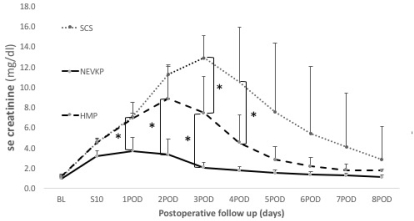Comparison of Continuous Normothermic Ex Vivo Kidney Perfusion to Hypothermic Preservation Methods in Pig Kidneys Donated after Cardiac Death
1Multi Organ Transplant Program, TGH, Toronto, ON, Canada
2Division of Nephrology, The Hospital of Sick Children, Toronto, ON, Canada
3Dept. of Surgery (Urology) & Physiology, The Hospital of Sick Children, Toronto, ON, Canada
4Dept. of Medicine and Institute of Medical Science, UHN and Univ. of Toronto, Toronto, ON, Canada.
Meeting: 2018 American Transplant Congress
Abstract number: B16
Keywords: Donors, Graft function, Kidney transplantation, Machine preservation, non-heart-beating
Session Information
Session Name: Poster Session B: Acute and Chronic Graft Injury
Session Type: Poster Session
Date: Sunday, June 3, 2018
Session Time: 6:00pm-7:00pm
 Presentation Time: 6:00pm-7:00pm
Presentation Time: 6:00pm-7:00pm
Location: Hall 4EF
Background: Strategies to decrease preservation-related injury in renal grafts donated after circulatory death urgently needed. This highlights the importance of direct comparison of dynamic preservation technologies for kidneys. Our prior work has suggested superior graft function of continuous normothermic ex vivo kidney perfusion (NEVKP) over static cold storage. Here we investigated whether NEVKP could promote functional recovery compared to hypothermic machine perfusion (HMP).
Methods: Porcine kidneys were exposed to 30min of warm ischemia, then auto-transplanted following either 16h of SCS, 16h of HMP (LifePort®) or 16h of NEVKP (n=5 each group). Graft function and histology were assessed.
Results: Grafts preserved by NEVKP demonstrated more rapid graft recovery, with the mean peak serum creatinine of 3.7±1.3mg/dl, occurring on day 1, compared with 8.8±3.2mg/dl in the HMP group, occurring on day 2, and 10.5±5.4mg/dl in the SCS group, occurring on day 3. Differences between daily serum creatinine levels reached significance between NEVKP and HMP on day 1 (p=0.002), day 2 (p=0.004) and day 3 (p=0.024), and between HMP and SCS on day 3 (p=0.016) and day 4 (p=0.046).  Injury scores [scaled from 0 to 3] were lower in both perfused groups (NEVKP, HMP): score: 1(1-1.5) compared to SCS group: score: 1.5(1-3) at POD 8, however this did not reach statistical significance.
Injury scores [scaled from 0 to 3] were lower in both perfused groups (NEVKP, HMP): score: 1(1-1.5) compared to SCS group: score: 1.5(1-3) at POD 8, however this did not reach statistical significance.
Conclusion:In this DCD model of renal autotransplantation, we demonstrated that NEVKP significantly improved initial graft function compared to either HMP or SCS. Thus, NEVKP may provide superior preservation options for DCD renal grafts than conventional hypothermic methods. The biologic mechanisms underlying NEVKP present new opportunities to advance these findings.
CITATION INFORMATION: Hamar M., Urbanellis P., Kollmann D., Linares I., Kaths M., Bagli D., Konvalinka A., Mucsi I., Ghanekar A., Robinson L., Selzner M. Comparison of Continuous Normothermic Ex Vivo Kidney Perfusion to Hypothermic Preservation Methods in Pig Kidneys Donated after Cardiac Death Am J Transplant. 2017;17 (suppl 3).
To cite this abstract in AMA style:
Hamar M, Urbanellis P, Kollmann D, Linares I, Kaths M, Bagli D, Konvalinka A, Mucsi I, Ghanekar A, Robinson L, Selzner M. Comparison of Continuous Normothermic Ex Vivo Kidney Perfusion to Hypothermic Preservation Methods in Pig Kidneys Donated after Cardiac Death [abstract]. https://atcmeetingabstracts.com/abstract/comparison-of-continuous-normothermic-ex-vivo-kidney-perfusion-to-hypothermic-preservation-methods-in-pig-kidneys-donated-after-cardiac-death/. Accessed December 26, 2025.« Back to 2018 American Transplant Congress
